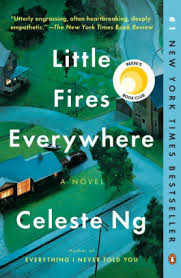Little Fires Everywhere: A Review
October 21, 2019
Mia Warren, a budding photographer, and her daughter Pearl are an unconventional, nomadic pair, who have found themselves in conflict, concerning love, art, and affection, with the Richardson’s, a suburban upper-class family from ‘90s era Shaker Heights, Ohio. The small, politically left town is expertly planned from the specific colors of the homes that line its curvy streets to the specific social cues that people must learn, unique to Shaker Heights. Mia and Pearl shake up the town upon arrival with their unconventional ways of thinking and artistic demeanor. The two families struggle between understanding their identity and doing what is right throughout Celeste Ng’s latest novel Little Fires Everywhere.
The opening chapter of the novel begins with Elena Richardson, or Mrs. Richardson and typically the leading culprit of raising conflict, waking up to her family’s home on fire. At first the family is unsure of how it could have started, but she tells them, “The fireman said there were little fires everywhere.” This begs the reader to question, who started the fire? And more importantly, why?
From there, the novel flashes back to the summer before the house fire when Mia and Pearl moved into a small duplex owned by Mrs. Richardson. Soon after, Pearl becomes good friends with Mrs. Richardson’s youngest son Moody, who serves as Pearl’s gateway to Shaker Heights and her relationship with the rest of the Richardson family. The two families become extremely close, intertwining nearly all aspects of their lives, including; work, pleasure, and consultation.
A certain kind of weariness of her neighbor soon grows within Mrs. Richardson who digs into Mia’s past and is surprised by what she finds about Mia’s reason for becoming a mother. While this is occuring, the author expertly connects Bebe Chow, a working class, Chinese immigrant who is fighting for the custody of her biological daughter, May Ling, into the story. The town appears to be split between Bebe and the McCulloughs. The McCulloughs are a family of similar socio-economic standing as the Richardsons, who want to adopt the Chinese baby after she was abandoned by her mother. The civil court case drives divisions between the town and more specifically between Mia and Mrs Richardson.
Throughout the novel the narration is from a 3rd person point of view, meaning the narrator uses pronouns like he, she and they instead of you, we, I or me, which is necessary to tie in all the events that occur in the novel because at some points the plot and character relations become very complex. The narrator is not named, they seem to be an omnipresent figure who tells the story of each character as an onlooking witness. This tactic is typically not used in fiction writing, as most novels are written in the first person, but makes for a great change in conventional writing styles.
Little Fires Everywhere raises questions about the ethics of motherhood by intertwining controversial topics and even more politically and morally charged opinions. Whether it be abortion, adoption, and even in-vitro fertilization the story is not short of heart wrenching events and that make the reader think to themselves, “just one more chapter”.
Little Fires Everywhere is a deeply empathetic novel that will constantly keep the reader coming back for more. The events that unfold throughout the novel provide a different perspective of life and love and how art influences it. But the most important theme of the novel is that everyone has the chance to start over, no matter what situation you find yourself in. Because, as Ng puts it, “…you need to scorch everything to the ground and start over. After the burning the soil is richer, and new things can grow.”
